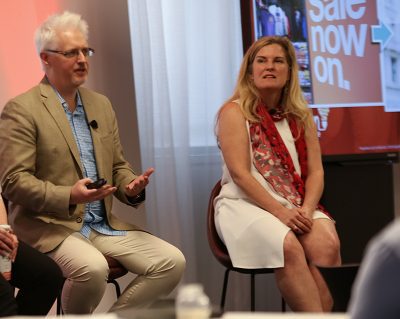You won’t find two more passionate advocates for experiential retail than Laura Davis-Taylor and Ed King, the co-founders of The HighStreet Collective. “Experience is the way forward in retail stores, and that’s no longer a theory — it’s absolutely mandatory,” said Davis-Taylor, the Collective’s Principal Consultant for Retail Experience Strategy. “My hope is that it doesn’t become a cliché term rather than an active strategy for retailers.”
Davis-Taylor and King, who is Principal Consultant for Retail Customer Experience at HighStreet Collective, discussed just how crucial experience is to the future of stores in an interview with Retail TouchPoints. This was also a key theme of the Digital Experience Forum they co-hosted in conjunction with the Digital Signage Expo in March, and their presentation at the 2018 Retail Innovation Conference.
Some key takeaways include:
- To do experiential retail right, weave stores into your attribution models;
- Focus on creating positive emotions when designing an experience strategy;
- Supplier strategy is now about pitching to the Chief Marketing Officer (CMO) rather than the CIO;
- Target the ACES — the Addictively Connected Experience Seekers; and
- Try something, measure it, see if it moves the needle in 30, 60 or 90 days.
Retail TouchPoints (RTP): People have been talking about experiential retail for a while. What’s different now, and how can retailers make sure it’s not just another buzzword?
Laura Davis-Taylor: One thing that’s different now is the critical nature of measurement. We’re not talking about doing experience for experience’s sake. Now you can prove that what you’re trying to do experientially will have a positive revenue effect.
Of course, to do this right, you need to properly weave stores into your attribution models. When that happens, retailers can finally ‘open the kimono’ about the value that the store provides — how it connects the dots from generating traffic to driving customers to the registers. It needs to be threaded into the omnichannel world so that the experience for customers is totally channel-less.
RTP: Why is creating an experience strategy so critical now?
Davis-Taylor: One of our speakers at the Digital Experience Forum, Phillip Raub of b8ta, noted that we are all so digitally enabled now that the Internet is like air — we just expect it to be there. In order for retailers to start taking advantage of this digital enablement, they need to quit strategizing, measuring and giving credit in the traditional silos of store, online and mobile. That’s not an experience design; that’s a channel strategy.
Another thing is that the means of commerce are changing. There’s certainly still a role for the store, but retailers need to realize that in some areas, we’re not playing with the same weapons. We’re not even on the same battlefield! If Amazon is changing its prices 2.5 million times per day, there’s no way you can match that.
Ed King: Some of it is the reality of GAFA, which stands for Google/Apple/Facebook/Amazon. All these tech companies are creeping into our space. To combat that, you need to be you, and you need to focus on the customer, not the competition.
RTP: What are some of the major elements of an experience strategy in retail?
King: A big piece of it is optimizing positive emotions at every potential touch point. When we can measure emotions, that goes a long way toward understanding the “why” of what’s happening in a store. We can now see whether an experience lit someone up emotionally.
Davis-Taylor: If you’re talking about an experience strategy, you can’t do it without creating positive emotions.
RTP: What are some of the ways this emphasis on experience and emotion are affecting retail?
King: For one thing, the supplier strategy for those targeting retailers should now be about pitching to the Chief Marketing Officer (CMO) rather than the CIO. At the Digital Experience Forum, the integrators and technicians in the audience had been used to selling hardware and software to a CIO. Now they need to reframe the conversation to be more focused on what the CMO wants, because that’s where the budgets are coming from. There wasn’t a specific day that the shift from CIO to CMO happened, but there was a tipping point. We went from working toward a technology purpose to a marketing-experiential outcome-ROI purpose. Now solution providers need to talk the language of ROI, measurement, engagement and target market analysis. These emotional triggers, or goosebumps per square foot, are the new language.
In terms of the consumer, it’s about attracting the ACES — the Addictively Connected Experience Seekers. The digital native generations like Millennials and Gen Z have the idea that they can, with technology, get anything they want at any time they want. Yet they still seek experiences. One survey found that when given a choice between shopping online and in a brick-and-mortar store, 70% of Millennials chose the store, and 77% of Gen Z respondents did.
These generations have touched glass for their whole life, so they are craving these tactile, physical things. They love the convenience that technology allows, so stores need to give that to them in spades — but pair it with sensory physical experiences.
RTP: What are some best practices for retailers seeking to innovate along these lines?
King: Retailers need to realize that nobody is doing any of this perfectly. Everyone is still trying to find their way. Retailers can’t afford to wait to see who the “guiding light” is and copy them. I believe everyone will need to create their own test-and-learn strategy. Try something, measure it, see if it moves the needle in 30, 60 or 90 days. If it does, take it to 10 stores, and if it continues to work, take it to 100 stores. See what works and what your customers really like.
Davis-Taylor: You also need a leader who will not only preach about innovation but will incentivize toward it. You need an empowered leader, a vision of what you’re trying to do, and the tools in place to learn what’s working and to tweak what’s not. The point is that there’s no failure, there’s only learning. There’s nothing wrong with failing if you’re failing forward.













